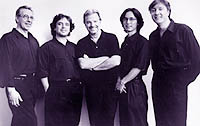
October 18, 1999
'New tango' master to perform at UCSC
By Barbara McKenna
When he first introduced the world to "new" tango in the late 1940s and
early '50s, Argentinian composer and bandoneón virtuoso Astor Piazzolla sparked
responses ranging from perplexed to outraged. One critic was allegedly so infuriated
that he burst in on a radio interview and put a gun to Piazzolla's head, evidently
hoping to scare the composer out of his blasphemous ways.
 |
| The Pablo Ziegler Quintet for New Tango performs Thursday, October 28, at 8 p.m at UCSC's Music Center Recital Hall. For tickets, call (831) 459-2159. |
But even to this day there are critics. Ask Pablo Ziegler. Ziegler, Piazzolla's pianist for a decade, now heads his own ensemble and is considered this generation's master of new tango.
Ziegler's group, the Pablo Ziegler Quintet for New Tango, will perform at UCSC
in late October as part of Arts &
Lectures' 1999-2000 season.
"There are still many traditionalists today who object to new tango," he
said. "To them, to change the tango is to change the national flag." Even
his friends were dismayed when Ziegler told them he was leaving his jazz trio, Pablo
Ziegler Terceto, to play with Piazzolla.
"Ah, it was terrible," he recalled. "A lot of my friends were saying,
'No, this is not tango." I said, "Get out! This is wonderful tango. This
is new tango. This is tango for now and for the next century.'"
If any music is going to provoke such ardor, it's no surprise that it's tango: Born
out of the the Buenos Aires ghettos at the turn of the 19th century, tango articulates
the extremities of its world--passion, aggression, hope, fear. True to its roots,
new tango voices the sultry inflections and seductive phrasings of traditional tango
but creates a complex interplay with classical and jazz forms such as counterpoint,
fugue, and improvisation.
"Astor Piazzolla makes the big revolution in tango in 1946-48, taking it from
the dance floor to the concert stage," Ziegler said. "He had a very good
knowledge of the tongue of music--how different kinds of music speak together in
harmony--and with that he really invents a new music."
In 1978 Piazzolla was looking for a pianist and Ziegler, then 33, was his choice.
Ziegler's background was eclectic: Trained from the age of 4 until 13 in a classical
music conservatory, he learned tango on the side from his father, a tango violinist.
As a teenager Ziegler fell in love with jazz, cutting his teeth on the likes of Chick
Corea and Weather Report.
Until he joined the Astor Piazzolla Quintet, Ziegler had never performed tango
professionally, but his virtuosity in improvisation was exactly what Piazzolla wanted.
"At that time, tango piano players only understood how to play straight tango,"
Ziegler explained. "Piazzolla wanted someone informed in classical and jazz."
Although he had been playing professionally for nearly 20 years when he joined Piazzolla's
quintet, Ziegler looks at his decade with the band as a learning experience.
"It was the New Tango University for me," he said. And what Ziegler
learned from his mentor was not just a musical style but the art of innovation. When
he started his own quintet in 1992, Ziegler changed the mix, replacing the traditional
violin with a drum.
"I heard in my mind the sound of the quintet with drums and I wanted to try
it," he explained. "New tango already has a complex rhythmical structure,
but the drum gives us small possibilities of freedom--ways to explore with the rhythm."
Another innovation was less intentional--and less successful. Ziegler launched his
ensemble without tango's traditional bandoneón (a German accordion).
"After playing with Piazzolla it was impossible for me to work with another
bandoneón player. But I realized that tango without the bandoneón,
it's like playing jazz without sax." Ziegler now performs with bandoneón
player Hector del Curto. "He's fantastic," Ziegler said.
Also performing with the quintet on this tour are Pablo Aslan on bass, guitarist
Claudio Ragazzi, and drummer Satoshi Takeishi.
As he added his own innovations, Ziegler says there is something he never forgets:
"Tango comes from the dancers, from dancing close, and from the attitude, the
camorra (cockiness). There is in tango an intense relationship between the man and
the woman--sometimes provocative and sometimes very sweet. I try to maintain that
relationship and to write the music to the relationship of the dancers.
"The secret code to playing tango is to feel it in the body," he added.
"I always say to the group, we must try to dance with the music. Because, if
five musicians dance to the same rhythm you get fantastic results, no?"
Judging by the fact that Ziegler has released three CDs in the last two years; is
featured on the PBS special, "Tango Magic"; consistently arouses awe in
even the most jaded music critics; and sells out shows months in advance; the results
have been fantastic, yes.